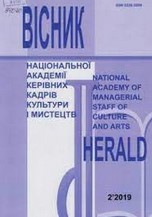ВІДНОВЛЕННЯ КИЄВО-ПОДІЛЬСЬКОЇ ПОКРОВСЬКОЇ ЦЕРКВИ В 1950-Х РОКАХ: МОНУМЕНТАЛЬНИЙ ЖИВОПИС ЛІДІЇ СПАСЬКОЇ
RESTORATION OF THE KYIV-PODIL POKROVSKA CHURCH IN THE 1950S: MONUMENTAL PAINTING BY LIDIA SPASKA
Author(s): Labzin VyacheslavSubject(s): Architecture, History of Church(es), Visual Arts, Post-War period (1950 - 1989), Eastern Orthodoxy, History of Art
Published by: Національна академія керівних кадрів культури і мистецтв
Keywords: Lidia Spaska; Kyiv-Podil Pokrovska Church; religious painting; Lamentation; Entombment; Resurrection; Apparition of the Virgin Mary;
Summary/Abstract: The purpose of the article is to find out the history of Lidia Spaska's painting during the restoration of the Kyiv- Podil Pokrovska Church in the 1950s, and its iconographic and stylistic features. The research methodology is based on the application of archival and bibliographic searches, which enabled finding and highlighting the unknown facts; iconographic and iconological methods, which made it possible to analyse the development of plots, and the method of comparative evaluation allows to clarify the peculiarities of the artist's approach to their interpretation. The scientific novelty consists in the introduction into scientific circulation of previously unknown materials about L. Spaska's participation in the restoration of the Kyiv-Podil Pokrovska Church in the 1950s; in the first attempt at an iconographic and iconological analysis of her monumental paintings in this restoration process. Conclusions. It has been established that Lidia Spaska was the author of the monumental painting of the Kyiv-Podil Pokrovska Church. The following works belonged to her brush: two compositions “The Entombment” and “The Resurrection” in half-domes; two wall paintings in the northern and southern arms – “Ascension of Virgin” and “Apparition of Virgin on Mount Pochaiv”; paintings of the drum of the central dome and elastic arches. These works have not survived in their original form to our time. The iconography of the images gives reason to believe that L. Spaska did not use fixed subjects, but on the basis of her knowledge and experience tried to interpret or adapt them to the wishes of the customer, as evidenced by their iconographic analysis. The compositions of all works are subordinated to the architectural space and are organically perceived in the general interior of the temple. In her painting, L. Spaska focused on the fine modeling of the face, giving it increased attention, while the clothes and the background were painted more generally; the figures are characterised by expressive silhouette and movement. Losses and later renewals of paintings do not allow us to draw general conclusions about the color and its features.
Journal: Вісник Національної академії керівних кадрів культури і мистецтв
- Issue Year: 2022
- Issue No: 3
- Page Range: 141-148
- Page Count: 8
- Language: Ukrainian

